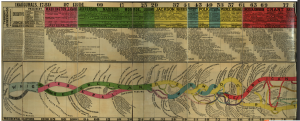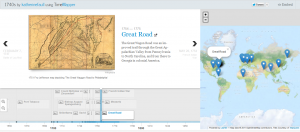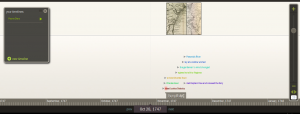Since memories become blurred as time goes by, the existing documents, journals and images are extraordinarily important records for people to understand history. Nowadays, historians tend to use both the chronology and geography to interpret history in a more digital way. “While history dealt in stories, chronology dealt in facts”.[Grafton] Chronology is widely used among historians. However, as what Hayden White described it as a “rudimentary form of histrography”[Grafton], chronology doesn’t give us all specific events which happened in a particular year. Its function lies in giving reader a line of the historical structure of that period of time. In this case, I inevitably related his words to the image which we were talking about this following image during the class.

political history into a single visual picture.
The shortage of this image lies in the missing history in the eighteenth century. It is easily recognized that the part which close to present time is much more twisted and complicated than the part in eighteenth century. It doesn’t mean that more events happened in the present time, but mean that most part of eighteenth century history were not written down.
As Grafton mentioned in the text, scholars in Europe used tables to record events which traced back as early as fourth century. Different from the typical chronologically tables during the fourth century, people have more convenient tools. During this week, we learned how to use TimeMapper and Timeglider. For me, TimeMapper is really interesting. Below is a screen shot of my slide— Great Wagon Road.

As Great Wagon Road is a very long road from Philadelphia to South Georgia, it’s really hard to make a specific location spot on the map on the right hand. Eventually, I choose the location where Payne mentioned Great Road in his Journal. When we are doing some readings, it’s hard to relate one event to another according to its location and time. However, TimeMapper did it for us. We can compare these events and search for whether they have any relationship. Another advantage of TimeMapper is that one can quickly find the slide they are looking for by zooming in and out the timeline at the bottom.
While TimeMapper give us a broader overview of historical events which has some relationship with the journals, the Timeglider timeline aimed to analyze the chronology of Payne’s journal itself. By inputting important event during their travel, such as what they did, where were they, when did that happen. We can also add images on the top to help interpret the whole case. Below is what I did for my part of the journal.
Leave a Reply